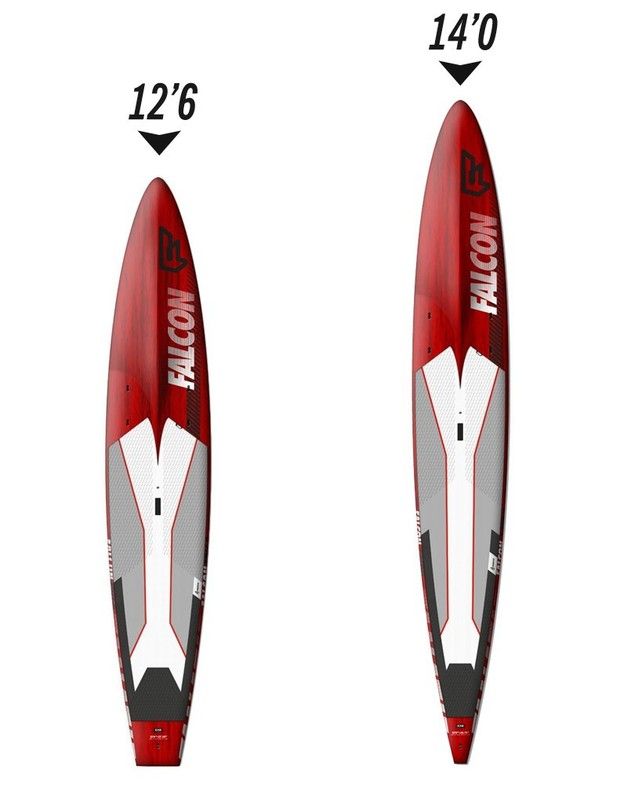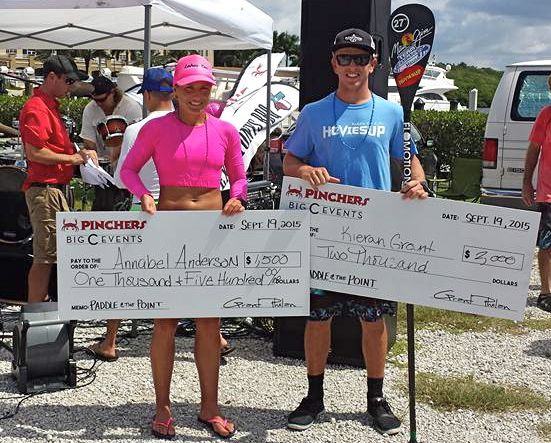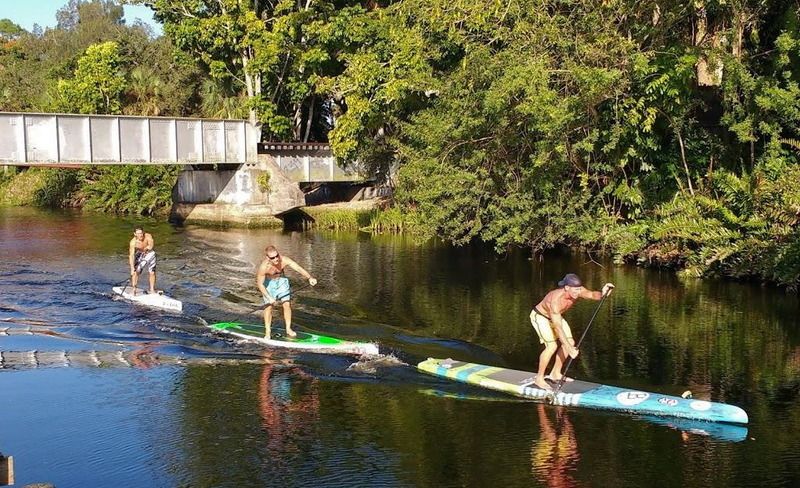1. Do it standing up.
2. No sails or motors allowed.
3. Refrain from using your paddle as a weapon.
However, there a few SUP rules that seem to be major sticking points for debate. The three things that always get argued are:
1. Board classes and design regulations
2. Gender divisions (and to a lesser extent, age divisions)
3. Drafting regulations, especially in relation to 1&2
I’ll join the debate by sharing my current views on each of those three areas. I might change my views later. These are just my thoughts as of one year of SUP racing:
1. Board classes and design regulations.

First let’s consider what it would be like if there were no rules about equipment. I.e., if everyone paddled whatever size and shape of board was fastest for him or her. The optimal board length for most racers would be longer than what most people use now, because longer boards have a higher potential “hull speed.” (Hull speed is related to the dynamics of the wave that propagates from a water-displacing vessel. It’s very hard to go faster than the speed of that wave, but a vessel with a longer hull creates a longer, faster wave. Therefore a longer vessel can get to a faster speed before it starts pushing into the backside of its own wave.) The hull speed of an 11’ board is 8.2 kph; the hull speed of an 18’ board is 10.5 kph. Longer is faster. Of course, increasing your board’s length only works up to a certain point, because there Is a type of drag called skin friction which is proportional to the surface area of the board that is in contact with the water. At some board length, the negative effect of more skin friction negates the benefit of increased hull speed, because you can’t paddle hard enough to overcome the skin friction to reach the hull speed, anyway. Making the board really narrow can help reduce skin friction, and also help get around the hull speed limit. However, boards narrower than about 23” become prohibitively hard to balance on. If your balance is off you can’t paddle forcefully enough to be fast, and falling in the water is obviously slow, too, so there’s a self-enforcing minimum width limit.
Anyway, exactly what the “board length of no additional benefit” is depends on how narrow the paddler can go without getting wobbly, and how big and strong the paddler is. Since a bigger, stronger paddler can overcome more skin friction, a bigger stronger paddler can potentially reach the hull speed on a bigger, longer board. This suggests that without board length restrictions, the biggest paddlers on the biggest boards would dominate, although somewhat smaller paddlers with incredible balance abilities to ride narrow boards might also have a shot. With no board design restrictions we might also see more foot-operated rudders, and maybe even some wacky features like outriggers to stabilize super narrow, round-hulled boards that would be too unstable to stand on otherwise. Bigger, more complicated boards would be more expensive and harder to transport, and would be more cumbersome in races with rough water, lots of turns, etc. They might be less fun, too. Those factors, combined with the likely disadvantage for smaller people in unrestricted competition, create a good argument for having some kind of limits on or divisions by board size. The question then is what those limits or divisions should be.
Because board width tends to be self-limiting as mentioned above, board width rules or divisions are rarely specified- at least not at the amateur races I attend. But most SUP races do include at least two board length classes: 12’6 and 14’. Some races also include an unlimited length class, and some include a “recreational” or “surf style” class. Here’s what I think about each class:
The surf style class is a catchall for non-racing board designs, up to 12’6 in length but with wider, more rounded shapes. Since those are the kind of SUP boards most people start out on, it’s nice that they have a division that lets you use them to try out racing. You couldn’t really have a surf style class in a high-stakes competitive race, though, because people would start making fast “surf style” boards that were actually more like raceboards.
The unlimited length class is nice, in theory. It just doesn’t seem to be very popular. Though I’ve been to several big amateur SUP races in Florida I don’t think I’ve ever seen more than two people register in the unlimited class. More unlimited boards come out of the woodwork for super long distance races like the Chattajack in Tennessee. Also, specialized open-ocean unlimited boards are popular for downwind racing at a few select spots in the world like Hawaii. I’m curious to see if there are any changes in the popularity of unlimited class racing in the future, but I’m not holding my breath.
The 12’6 and 14’ classes are each pretty popular. By virtue of their shorter length, 12’6 boards are a little more maneuverable- easier to turn, easier to handle in waves, and perhaps quicker to accelerate from a stop to their top speed. They are also slightly easier to store and transport. On the other hand 14’ boards are significantly faster at cruising speed- about 0.5 kph faster than 12’6. 14 footers are also a little more stable, meaning they can be narrower, which contributes to their speed advantage. They “track” better, too, so one can get more paddle strokes per side before having to switch sides. For most people it’s easier to go farther, faster, with less effort, on a 14’.
Yet there’s a common, mostly untrue belief that 12’6 is faster for light riders. There is a kernel of truth to the belief, because WITHIN the 12’6 class, lighter riders have a slight advantage over heavy ones. Likewise, WITHIN the 14’ class, moderate weight riders have some advantage over very light or very heavy riders. So even though 14’ boards are overall faster for almost everyone, if you’re very light and you want to be as fast as possible WITHIN A CLASS, you might want to pick 12’6. Anyway, people overextend the true notion that lighter people have an advantage in the 12’6 class into the untrue notion that lighter people are overall faster on 12’6 than 14’. One reason this misconception endures may be that when lighter riders try a 14’ board for the first time, they try a 14’ board that is too wide and heavy for them. The optimal 14’ for a light rider is a lot narrower than the optimal 14’ for a heavier rider, and having a lightweight construction to the board is more important when the rider is light.
In Florida I think about 2/3 of male racers use 14’ and about 9/10 of the women use 12’6. Sometimes race organizers offer both classes for both genders, but the prize awarding can be awkward if there aren’t enough men on 12’6 or women on 14’ to have a full podium of winners not-merely-by-default. Yet, if you only award prizes for 14’ for men, or only for 12’6 for women it kind of forces people to use a board size they may not want to use. This brings me to the gender divisions question.
2. Gender.

In SUP racing, the fastest men usually finish ahead of the fastest women. Of course, that difference is exaggerated by the fact that most men are on faster 14’ boards and most women are on slower 12’6 boards. If men and women were on the same length boards their speeds would be closer, but I think men would still be faster, on average, due to different physiology. So, gender divisions are probably necessary for fair competition. I don’t think there’s much controversy about that.
What there is controversy about is how prizes are apportioned among the genders- often unequally. If the prizes are money, I reckon the mens’ prizes and the womens’ prizes should be the same amount. That’s probably the best way to do it in a big race where the prize money comes from sponsors and you know there are going to be lots of competitors in both the mens’ and the womens’ divisions. However, if the prizes come from registration fees, and the number of participants is skewed strongly to one gender/class or another, then it might be fairer for the prize amounts to be based on the number of competitors in the class. For example, you could pay 20% of the class’ collective registration fees to first place, 15% to second, and 10% to third. E.g., if 50 women entered a race with a $40 entry fee, $2000 would be collected and first, second, and third prize would be $400, $300, and $200, respectively. (The rest of the money would offset costs of organizing the race.) If 20 men entered, $800 would be collected and the mens’ prizes would be $160, $120, and $80. You could do the same type of “awards based on the number of competitors” thing with board size divisions.
Division by gender makes sense. So does division by board length/type and division by age (typically 17 & under, 18-49, and 50+). But even though each division makes sense in itself, when you add them all together it multiplies the number of categories to the point of nonsense. Take the three age classes, times the four board classes, times the two genders and you get 3 x 4 x 2 = 24 unique classes, each of which will have a 1st, 2nd, and 3rd place award, so 72 prizes/trophies! Many of those will be unclaimed or uncontested, and therefore kind of silly. So you can see why races want to limit the number of categories. One common way of limiting the categories is to only award mens’ prizes in the 14’ class and only award womens’ prizes in the 12’6 class. I’m not crazy about that because it’s basically forcing the women to do a longer, harder race than the men, since the same distance takes longer and feels harder on a 12’6. I’d like to see what would happen if they made mens’ 14’ and womens’ 14’ the major prize classes. The 14’ class is usually interpreted to mean “any board up to 14’ in length,” so a woman could still use her 12’6 if she felt she was faster on it. Besides making the races closer, getting men and women on the same length boards could facilitate coed training, because men and women could stick closer together on the same workout paddles. This brings me to my third point.
3. Drafting regulations.

Drafting is when you follow very closely behind another racer, in his or her wake. The wake makes it so you don’t have to paddle as hard as when you’re on your own. When drafting you can keep up with someone who would be a bit faster than you going side-by-side. But drafting isn’t magic- you can’t keep up with someone who would be a LOT faster than you. Drafting is allowed because it makes the racing faster overall and it adds an interesting element of strategic competition/cooperation in “draft trains” of several riders. The main rule about drafting is that you can’t draft “out of class.” I.e., you may not draft behind someone of a different gender or someone on a different board length. I suppose this rule is to encourage riders within a class to race with and against each other rather than tagging along with the fastest out-of-class rider they can catch. I reckon the rule makes sense for highly competitive races with money involved, but for less serious amateur races I think an “anything goes” drafting rule would be better. In an amateur race there are a wide range of speeds in every class, and fewer opportunities to draft within class. A fast 12’6 woman might be side-by-side with a draft train of 14’ men, but under the “only draft within class” rule she would not be allowed to join their train. Allowing drafting out of class would give progressing racers more opportunities to practice drafting.
The final thing I want to say about drafting rules is: if you're going to have drafting rules, you need to enforce them. Otherwise you're just giving a handicap to the people who follow the rules.
That’s the end of the manifesto!

No comments:
Post a Comment